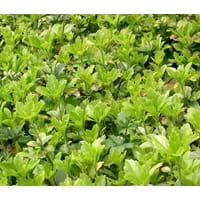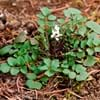Life Span
Annual
Perennial
Type
Herbs
Broadleaf Evergreen
Origin
Europe, Asia
China, Japan
Types
Admiral Pepper,Bell Pepper,Mohawk Pepper,Yolo Wonder Pepper
Pachysandra procumbens, Pachysandra terminalis
Habitat
Cropland, Oil fields, Waste areas
Deep, Hardwood forests, moist forests, Terrestrial
USDA Hardiness Zone
4-9
4-8
AHS Heat Zone
Not Available
Not Available
Sunset Zone
Not Available
21,22
Habit
Clump-Forming
Prostrate/Trailing
Flower Color Modifier
Not Available
Bicolor
Fruit Color
Green, Tan
Not Available
Leaf Color in Spring
Green
Dark Green
Leaf Color in Summer
Not Available
Dark Green
Leaf Color in Fall
Green
Dark Green
Leaf Color in Winter
Green
Dark Green
Leaf Shape
Egg-shaped
Toothed
Plant Season
Not Available
Spring, Summer, Fall, Winter
Sunlight
Full Sun, Partial Sun
Partial shade, Full Shade
Growth Rate
Very Fast
Medium
Type of Soil
Clay, Loam, Sand
Loam
The pH of Soil
Acidic, Neutral, Alkaline
Acidic, Neutral
Soil Drainage
Well drained
Well drained
Bloom Time
Early Spring, Spring, Late Spring, Late Fall, Early Winter, Winter, Late Winter
Late Spring, Early Summer
Tolerances
Pollution
Not Available
Where to Plant?
Ground, Pot
Ground
How to Plant?
Stem Planting, Transplanting
Rooted stem cutting, Seedlings, Stem Cutting
Plant Maintenance
Medium
Medium
Watering Requirements
Prefer drip-irrigation instead of Over-head watering, Water Deeply
Needs more water during establishment
In Summer
Lots of watering
Lots of watering
In Spring
Moderate
Moderate
In Winter
Average Water
Average Water
Soil pH
Acidic, Neutral, Alkaline
Acidic, Neutral
Soil Type
Clay, Loam, Sand
Loam
Soil Drainage Capacity
Well drained
Well drained
Sun Exposure
Full Sun, Partial Sun
Partial shade, Full Shade
Pruning
Prune ocassionally, Prune to control growth
Remove damaged leaves, Remove dead branches, Remove dead leaves
Fertilizers
All-Purpose Liquid Fertilizer
All-Purpose Liquid Fertilizer
Pests and Diseases
Not Available
Alternaria leaf blight, Red blotch, Stem rot
Plant Tolerance
Drought
Drought
Flowers
Insignificant
Insignificant
Flower Petal Number
Single
Single
Foliage Texture
Fine
Medium
Foliage Sheen
Not Available
Glossy
Attracts
Not Available
Ants, pollinators
Allergy
Not Available
allergic reaction
Aesthetic Uses
Not Used For Aesthetic Purpose
Ground Cover, Mass in beds, slopes
Beauty Benefits
Not Available
Not Available
Environmental Uses
Air purification
Air purification
Medicinal Uses
Not Available
Unknown
Part of Plant Used
Not Available
Fruits
Other Uses
Unknown
Planted in shelterbeds, Showy Purposes, Used for bedding in gardens
Used As Indoor Plant
No
Yes
Used As Outdoor Plant
Yes
Yes
Garden Design
Not Available
Edging, Groundcover
Botanical Name
CARDAMINE hirsuta
PACHYSANDRA terminalis
Common Name
Hairy Bittercress
japanese spurge, japanese pachysandra, carpet box
In Hindi
बालों वाली Bittercress
pachysandra
In German
Hairy Bittercress
Ysander
In French
Bittercress Poilu
pachysandra
In Spanish
Bittercress Peludo
Pachysandra
In Greek
τριχωτές Bittercress
Pachysandra
In Portuguese
Bittercress cabeludo
Pachysandra
In Polish
włochaty Bittercress
Runianka
In Latin
pilosus bittercress
Pachysandra
Phylum
Magnoliophyta
Vascular plant
Order
Brassicales
Buxales
Family
Brassicaceae
Buxaceae
Genus
Cardamine
Pachysandra
Clade
Not Available
Angiosperms, Eudicots
Tribe
Not Available
sarcococceae
Subfamily
Not Available
NA
Number of Species
Not Available
Not Available
Properties of Hairy Bittercress and Pachysandra
Wondering what are the properties of Hairy Bittercress and Pachysandra? We provide you with everything About Hairy Bittercress and Pachysandra. Hairy Bittercress doesn't have thorns and Pachysandra doesn't have thorns. Also Hairy Bittercress does not have fragrant flowers. Hairy Bittercress has allergic reactions like Not Available and Pachysandra has allergic reactions like Not Available. Compare all the properties and characteristics of these two plants. Find out which of these plant can be used as indoor plant. If you are interested to decorate your house and garden, find out aesthetic uses, compare them and select the plant which will beautify your surrounding. Along with beautification, try comparing medicinal and edible uses of Hairy Bittercress and Pachysandra and you can choose the plant having best and most benefits.
Season and Care of Hairy Bittercress and Pachysandra
Season and care of Hairy Bittercress and Pachysandra is important to know. While considering everything about Hairy Bittercress and Pachysandra Care, growing season is an essential factor. Hairy Bittercress season is Not Available and Pachysandra season is Not Available. The type of soil for Hairy Bittercress is Clay, Loam, Sand and for Pachysandra is Loam while the PH of soil for Hairy Bittercress is Acidic, Neutral, Alkaline and for Pachysandra is Acidic, Neutral.
Hairy Bittercress and Pachysandra Physical Information
Hairy Bittercress and Pachysandra physical information is very important for comparison. Hairy Bittercress height is 10.20 cm and width 5.10 cm whereas Pachysandra height is 6.00 cm and width 60.00 cm. The color specification of Hairy Bittercress and Pachysandra are as follows:
Hairy Bittercress flower color: White
Hairy Bittercress leaf color: Green
Pachysandra flower color: White
- Pachysandra leaf color: Dark Green
Care of Hairy Bittercress and Pachysandra
Care of Hairy Bittercress and Pachysandra include pruning, fertilizers, watering etc. Hairy Bittercress pruning is done Prune ocassionally and Prune to control growth and Pachysandra pruning is done Remove damaged leaves, Remove dead branches and Remove dead leaves. In summer Hairy Bittercress needs Lots of watering and in winter, it needs Average Water. Whereas, in summer Pachysandra needs Lots of watering and in winter, it needs Average Water.





